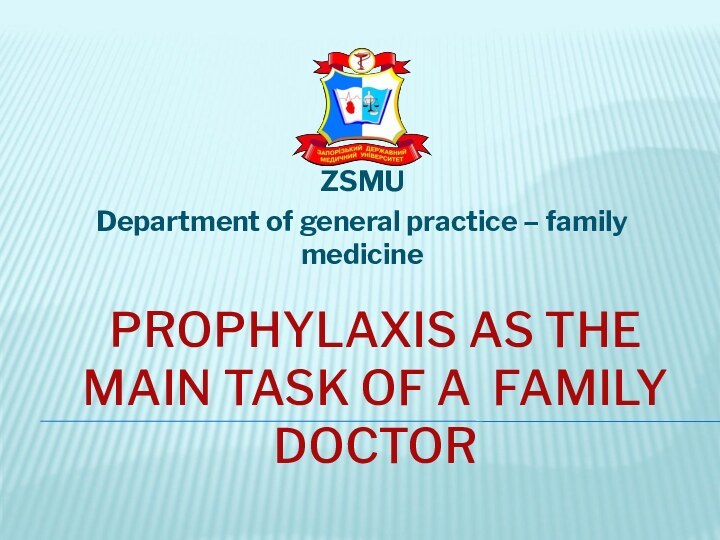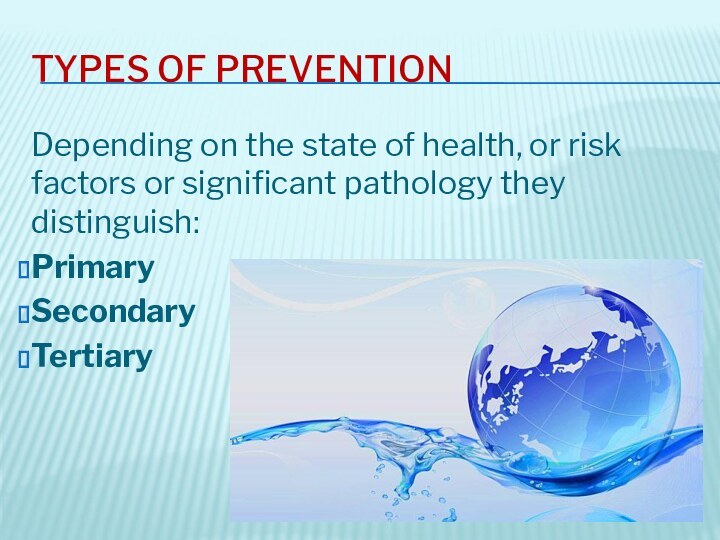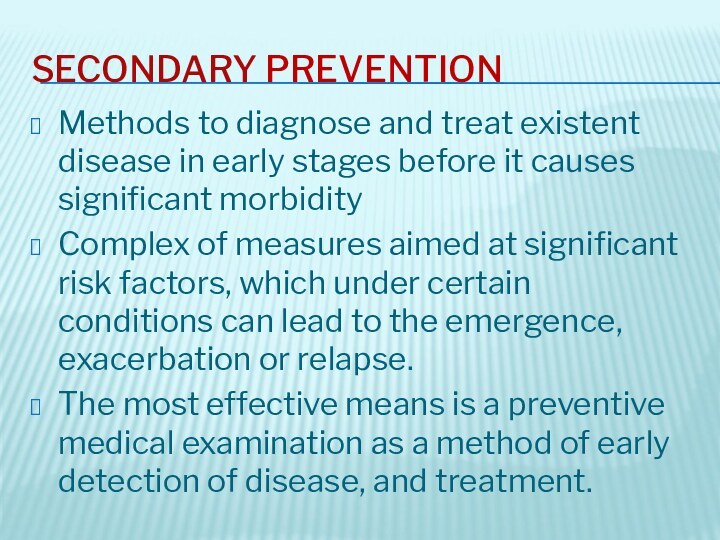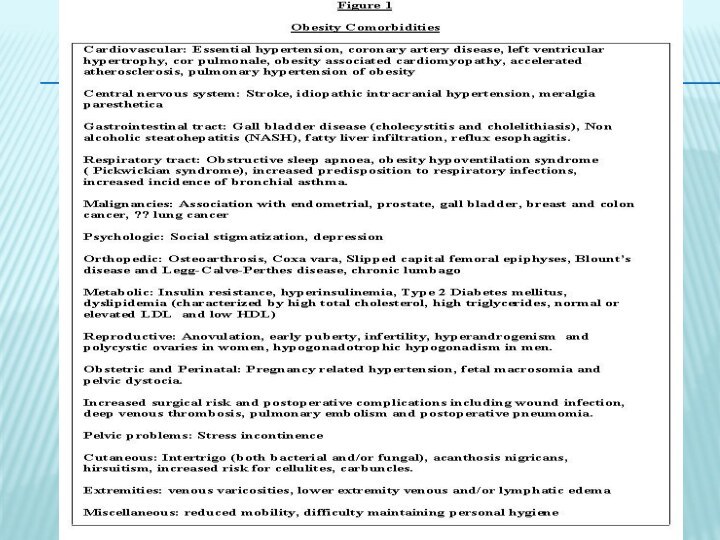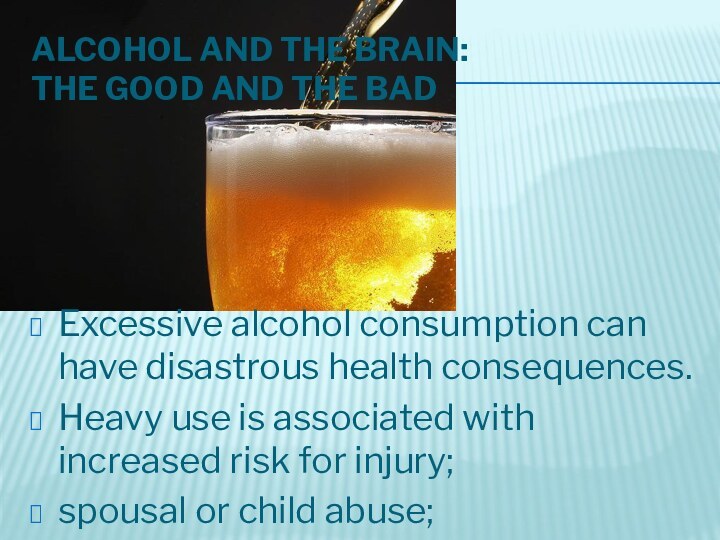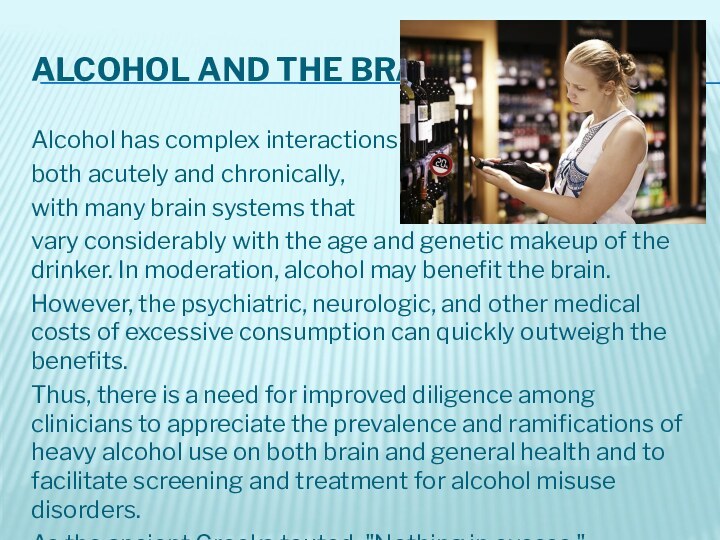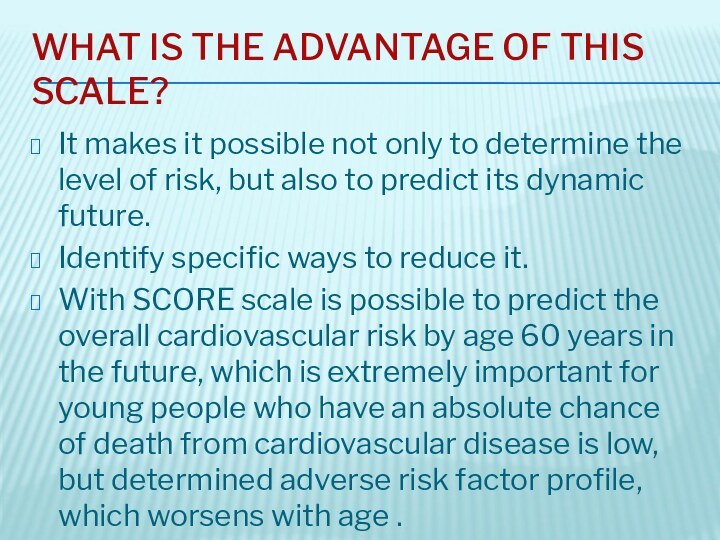Слайд 2
STRUCTURE OF PRIMARY CARE SERVICES
Слайд 3
PREVENTIVE MEDICINE
consists of measures taken to prevent diseases,
(or injuries) rather than curing them or treating their
symptoms.
This contrasts in method with curative and palliative medicine, and in scope with public health methods (which work at the level of population health rather than individual health).
Слайд 4
TYPES OF PREVENTION
Depending on the state of health,
or risk factors or significant pathology they distinguish:
Primary
Secondary
Tertiary
Слайд 5
PRIMARY PREVENTION
Methods to avoid occurrence of disease (vaccination,
rational work and rest, good nutrition, physical activity, the
environment, etc.).
Most population-based health promotion efforts are of this type.
Слайд 6
PRIMARY PREVENTION. FOR EXAMPLE:
education about good nutrition, the
importance of regular exercise, and the dangers of tobacco,
alcohol and other drugs
education and legislation about proper seatbelt and helmet use
regular exams and screening tests to monitor risk factors for illness
immunization against infectious disease
controlling potential hazards at home and in the workplace
Слайд 7
SECONDARY PREVENTION
Methods to diagnose and treat existent disease
in early stages before it causes significant morbidity
Complex of
measures aimed at significant risk factors, which under certain conditions can lead to the emergence, exacerbation or relapse.
The most effective means is a preventive medical examination as a method of early detection of disease, and treatment.
Слайд 8
SECONDARY PREVENTION. FOR EXAMPLE:
telling people to take daily,
low-dose aspirin to prevent a first or second heart
attack or stroke
recommending regular exams and screening tests in people with known risk factors for illness
providing suitably modified work for injured workers
Слайд 9
TERTIARY PREVENTION
Methods to reduce negative impact of existent
disease by restoring function and reducing disease-related complications
Set
of measures for the rehabilitation of patients.
Tertiary prevention is aimed at social, labor, psychological and medical (functional recovery of organs and body systems) rehabilitation.
Слайд 10
TERTIARY PREVENTION. FOR EXAMPLE
cardiac or stroke rehabilitation programs
chronic
pain management programs
patient support groups
Слайд 11
QUATERNARY PREVENTION
Methods to mitigate or avoid results of
unnecessary or excessive interventions in the health system
Слайд 12
PREVENTION
For many health problems, a combination of primary,
secondary and tertiary interventions are needed to achieve a
meaningful degree of prevention and protection.
While primary and secondary prevention interventions are clear in areas like cancer or heart disease, such distinctions may be less useful in talking about musculoskeletal disorders.
Слайд 13
PROPHYLAXIS
(Greek: προφυλάσσω to guard or prevent beforehand)
is any medical
or public health procedure whose purpose is to prevent, rather than
treat or cure, a disease or other medical issue.
prophylactic measures are divided between: primary prophylaxis (to prevent the development of a disease) and secondary prophylaxis (whereby the disease has already developed and the patient is protected against worsening of this process).
Слайд 15
RISK FACTOR
In epidemiology, a risk factor is a variable associated with
an increased risk of disease or infection.
The term "risk factor" was first coined by
former Framingham Heart Study Director Dr. William B. Kannel a 1961 article in Annals of Internal Medicine.
Слайд 17
RISK FACTORS OF CARDIOVASCULAR DISEASES
An epidemic of chronic
non-epidemic diseases, including cardiovascular, related to life style and
appearance because of physiological risk factors.
Cardiovascular disease is a leading cause of death. It is important to identify patient and treatment factors that are related to successful cardiovascular risk reduction in general practice.
Слайд 18
CLASSIFICATION OF RISK FACTORS OF CVD
Biological (non-modifiable) factors:
age
sex
or gender (male)
genetic predisposition (dyslipidemia, hypertension, glucose intolerance, diabetes,
and obesity)
Слайд 19
CLASSIFICATION OF RISK FACTORS OF CVD
Anatomical, physiological and
metabolic (biochemical) features:
dyslipidemia
arterial hypertension
obesity and the distribution of body
fat
diabetes mellitus
Слайд 22
CLASSIFICATION OF RISK FACTORS OF CVD
Behavioral factors:
Diet
Tobacco
smoking
Level of physical exercise
Alcohol consumption
Level of chronic stress.
Слайд 26
ALCOHOL AND THE BRAIN:
THE GOOD AND THE
BAD
Excessive alcohol consumption can have disastrous health consequences.
Heavy
use is associated with increased risk for injury;
spousal or child abuse;
Слайд 27
ALCOHOL AND THE BRAIN: THE GOOD AND THE
BAD
risky sexual practices;
and serious medical consequences, such as
liver disease, hypertension, and gastrointestinal cancers.
Chronic excessive alcohol use can wreak particular havoc on the brain, increasing the risk for dementia, stroke, and psychosocial impairment [Centers for Disease Control and Prevention. Fact sheets -- alcohol use and health. http://www.cdc.gov/alcohol/fact-sheets/alcohol-use.htm Accessed February 5, 2014.].
Слайд 28
ALCOHOL AND THE BRAIN
But mild to moderate consumption*
has been linked to various health benefits, including many
with implications for the brain.
*The US Food and Drug Administration defines "moderate alcohol consumption" as up to 1 drink per day for women and up to 2 drinks per day for men.
One drink is equivalent to 12 fluid ounces of regular beer, 5 fluid ounces of 12% alcohol wine, or 1.5 fluid ounces of distilled spirits.
Слайд 31
BOOZE AND THE BRAIN
Numerous studies suggest that mild

to moderate intake is protective against cardiovascular disease, perhaps
owing to the effects of alcohol itself and to antioxidant polyphenol compounds.
Red wine reportedly has the most benefit, whereas beer -- particularly dark beers, such as stouts and porters -- also has purported cardiovascular benefits, though to a lesser degree.
Specifically, alcohol consumption reportedly has antiatherogenic and anti-inflammatory effects and has been tied to improved cholesterol profiles, platelet and clotting function, and insulin sensitivity, all factors with potentially beneficial neurologic ramifications. [de Gaetano G, Di Castelnuovo A, Rotondo S, Iacoviello L, Donati MB. A meta-analysis of studies on wine and beer and cardiovascular disease. Pathophysiol Haemost Thromb. 2002;32:353-355: Matos RS, Baroncini LA, Précoma LB, et al. Resveratrol causes antiatherogenic effects in an animal model of atherosclerosis. Arq Bras Cardiol. 2012;98:136-142.
Bertelli AA, Das DK. Grapes, wines, resveratrol, and hearth health. J Cardiovasc Pharmacol. 2009;54:468-476.
Arranz S, Chiva-Blanch G, Valderas-Martínez P, et al. Wine, beer, alcohol and polyphenols on cardiovascular disease and cancer. Nutrients. 2012;4:759-781.]
Слайд 32
BOOZE AND THE BRAIN
Light to moderate alcohol intake
has also been linked with a lower risk for
both ischemic and hemorrhagic stroke [Jimenez M, Chiuve SE, Glynn RJ, et al. Alcohol consumption and risk of stroke in women. Stroke. 2012;43:939-945]
However, heavy consumption is associated with increased risk for hemorrhagic stroke and more severe ischemic cerebral events [Casolla B, Dequatre-Ponchelle N, Rossi C, Hénon H, Leys D, Cordonnier C. Heavy alcohol intake and intracerebral hemorrhage: characteristics and effect on outcome. Neurology. 2012;79:1109-1115; Ducroquet A, Leys D, Al Saabi A, et al. Influence of chronic ethanol consumption on the neurological severity in patients with acute cerebral ischemia. Stroke. 2013;44:2324-2326.]
It should be pointed out that many of the studies looking at the impact of alcohol on cardiovascular health were observational and do not prove causality.
Слайд 33
COGNITION AND DEMENTIA
Limited alcohol use has also been
associated with a lower risk for dementia
Heavy consumption appears
to be severely detrimental to the brain. One study found that middle-aged men who drink more than 2.5 drinks daily are more likely to undergo faster decline in all cognitive areas -- particularly memory -- over a period of 10 years (Neurology, January 2014 )
Animal studies suggest that fish oil might be protective against alcohol-induced dementia by attenuating the neuronal degeneration caused by heavy alcohol use.
Слайд 34
THE DEVELOPING BRAIN
Image from Thinkstock
Слайд 35
PSYCHOSOCIAL IMPACT
Excessive alcohol use can contribute to psychiatric
pathology, with nearly one third of abusers suffering from
a mental illness.
Alcohol is well known to have considerable psychosocial ramifications for those who abuse it, including increased risk for legal troubles, social and occupational impairment, and domestic abuse, and a higher likelihood of attempting and committing suicide.
Overindulging can also bring about symptoms that mimic a wide range of psychiatric conditions, including mood, anxiety, psychotic, sleep, sexual, delirious, and amnestic disorders.
The psychiatric manifestations of alcohol may be partially mediated by its influence on neurotransmitter function, particularly the loss of serotonergic function. Women are far more vulnerable to the serotonergic imbalance caused by heavy drinking than are men.
Слайд 36
THE NEUROSCIENCE
The alcohol produces increases in dopamine in
the mesocorticolimbic reward pathway.
In social drinkers, subjective intoxication
during intravenous ethanol administration activates reward circuitry, including the nucleus accumbens. This activation contributes to the subjective experience of pleasure and weakens responses to fearful stimuli.
Heavy drinkers exhibit blunted nucleus blunted activation with alcohol consumption, suggesting that they experience a reduced pleasure response. In social drinkers, alcohol also enhances nucleus accumbens activation to a risky choice and dampens the response in striatum, thalamus, and insula to both positive and negative outcomes. Thus, risky behavior may be experienced as more rewarding under the influence of alcohol, whereas consequences are less salient.
Image courtesy of nimh.nih.gov
Слайд 37
ALCOHOL AND THE BRAIN
Alcohol has complex interactions,
both
acutely and chronically,
with many brain systems that
vary
considerably with the age and genetic makeup of the drinker. In moderation, alcohol may benefit the brain.
However, the psychiatric, neurologic, and other medical costs of excessive consumption can quickly outweigh the benefits.
Thus, there is a need for improved diligence among clinicians to appreciate the prevalence and ramifications of heavy alcohol use on both brain and general health and to facilitate screening and treatment for alcohol misuse disorders.
As the ancient Greeks touted, "Nothing in excess."
Слайд 38
Evaluation of cardiovascular risk
Слайд 39
EVALUATION OF CARDIOVASCULAR RISK
SCORE - is the abbreviation
of English words, which translated means "the systematic assessment
of coronary risk";
The above scale proposed by the expert group of the European Society of Cardiology in 2003, was developed based on the results of prospective studies conducted in 12 European countries (the total number surveyed was 205 178 persons).
Слайд 40
SCORE
According to SCORE there such degrees of risk
for cardiovascular complications:
moderate risk;
5,1-8,0% - high risk;
> 8% - a very high risk
Слайд 42
SCORE
The scale SCORE consists of two halves: the
left for women and the right for men.
In each
half columns are available for smokers and non-smokers.
The columns are made up of 5 large squares, age-appropriate (bottom-up: 40, 50, 55, 60 and 65).
In a larger square rows match the level of systolic pressure and columns - the level of cholesterol.
The numbers in the cells shows percent of risk of death in the next 10 years due to CVD.
Слайд 43
SCORE
Note that only three categories of people who
automatically belong to the high risk group, do not
require a risk assessment on a scale SCORE: these patients with diagnosed coronary heart disease, with diabetes and those who have extremely high levels of individual risk factors. The rest of the population is subject to a risk on a scale SCORE.
Слайд 44
WHAT IS THE ADVANTAGE OF THIS SCALE?
It makes
it possible not only to determine the level of
risk, but also to predict its dynamic future.
Identify specific ways to reduce it.
With SCORE scale is possible to predict the overall cardiovascular risk by age 60 years in the future, which is extremely important for young people who have an absolute chance of death from cardiovascular disease is low, but determined adverse risk factor profile, which worsens with age .
Слайд 45
RISK FACTORS FOR RESPIRATORY DISEASES
External risk factors -
long term smoking, industrial and household emissions, respiratory infections,
low socioeconomic status, use of certain drugs, allergens;
Слайд 46
INTERNAL RISK FACTORS
Genetic, bronchial hyperresponsiveness, atopy, the incomplete
development of the lungs, obesity.
Слайд 47
RISK FACTORS FOR DISEASES OF THE DIGESTIVE SYSTEM
Nutritional
factor;
Neuropsychiatric factors;
Unhealthy habits;
Chronic intoxication process;
Occupational factors;
Genetic factor;
H. Pylori;
Слайд 48
RISK FACTORS FOR DISEASES OF URINARY SYSTEM
Catarrhal diseases,
hypothermia;
abnormalities, genetic factor;
trauma and injury, physical strain;
infectious diseases (otolaryngology);
poisons,
drugs, intoxication;
heart disease and blood vessels and other internal organs;
pregnancy, cancer, constipation, etc.
